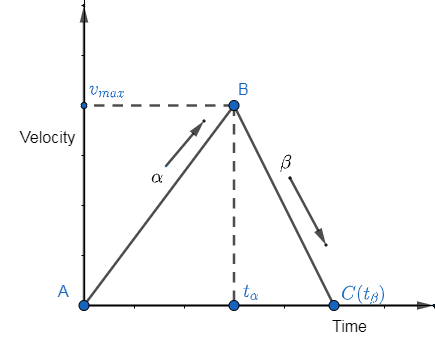Question
Question: A car accelerates from rest at a constant rate \(\alpha\) for some time after which it decelerates a...
A car accelerates from rest at a constant rate α for some time after which it decelerates at a constant rate β to come to rest. If the total time elapsed is t, the maximum velocity acquired by the car is given by
(a) (αβα2+β2)t
(b) (αβα2−β2)t(c) (αβα+β)t(d) (α+βαβ)t
Solution
Hint: Assuming the maximum velocity, the one relation that relates all the given quantity is v=u+at. Using this and dividing the entire time span in two parts, the question can be solved easily.
Complete step by step answer:
Let us consider the car accelerates from rest at a constant rate α for time tα to reach a maximum velocity of vmax. Therefore, we may write using the equation,
v=u+at
where, v is the final velocity, u is the initial velocity, a is the constant acceleration and t is the time taken. In this case,
v=vmax,u=0,a=α,t=tα
Therefore, we get,
vmax=0+α×tα …(I)
Again, let us consider, the car decelerates from vmax to rest at a constant rate of β for time tβ. Hence, we have,
v=0,u=vmax,a=−β,t=tβ
Therefore, we get,
0=vmax−β×tβ …(II)
Drawing the car’s journey on a graph, we get

From the above graph, AB is the car's acceleration journey and BC is the decelerated journey.
From the question we know, the entire time taken is t, where t=tα+tβ. Solving Eq. (I) and (II) for tα and tβ, we get,
tα=αvmax, tβ=βvmax
Therefore, substituting this value in the below equation, we get
t=tα+tβ
t=αvmax+βvmax
Now taking out the common term, we get
t=vmax(α1+β1)
Taking LCM and solving, we get
t=vmax(αβα+β)
vmax=(α+βαβ)t
Therefore, the correct option is D.
Note: If you look closely into the options, you would notice that they are of different dimensions. Hence, without even doing the sum, by performing a simple dimensional analysis, one can say the correct answer is D. It’s a trick that comes handy in a lot of such sums.
